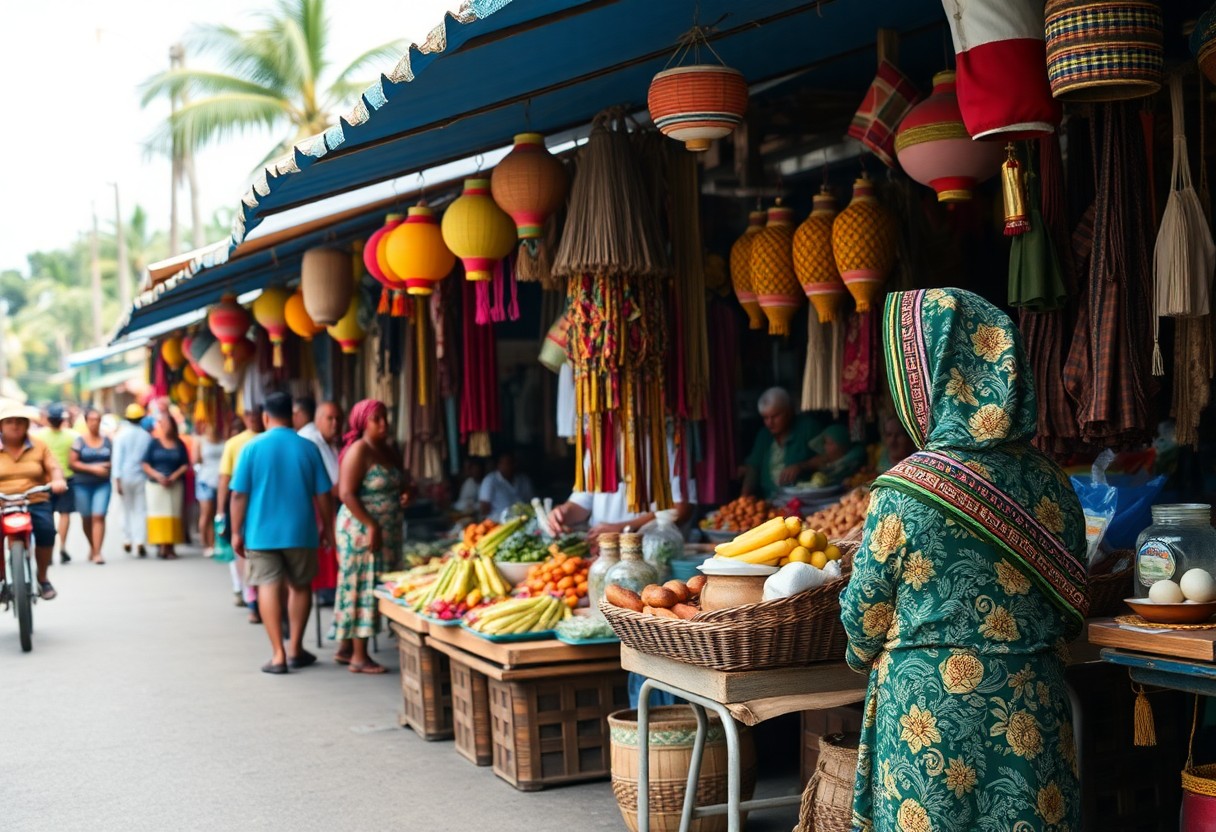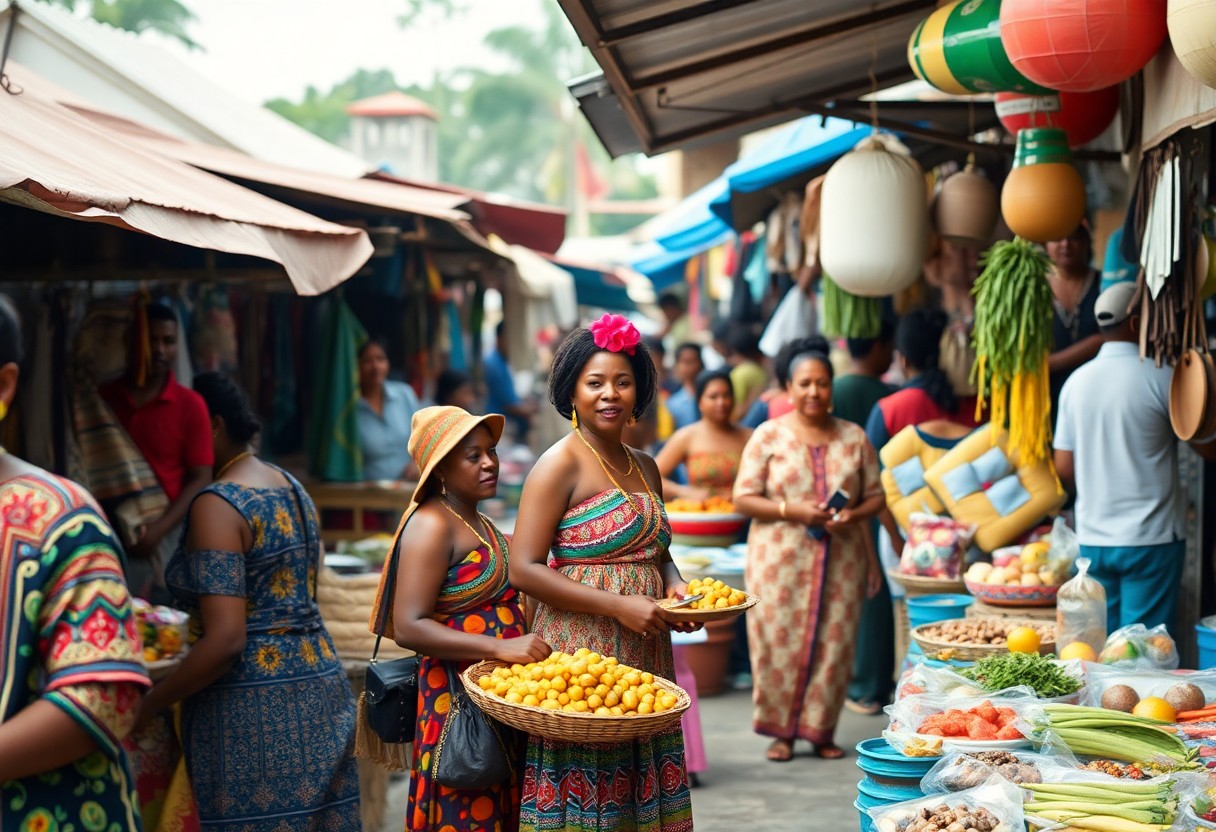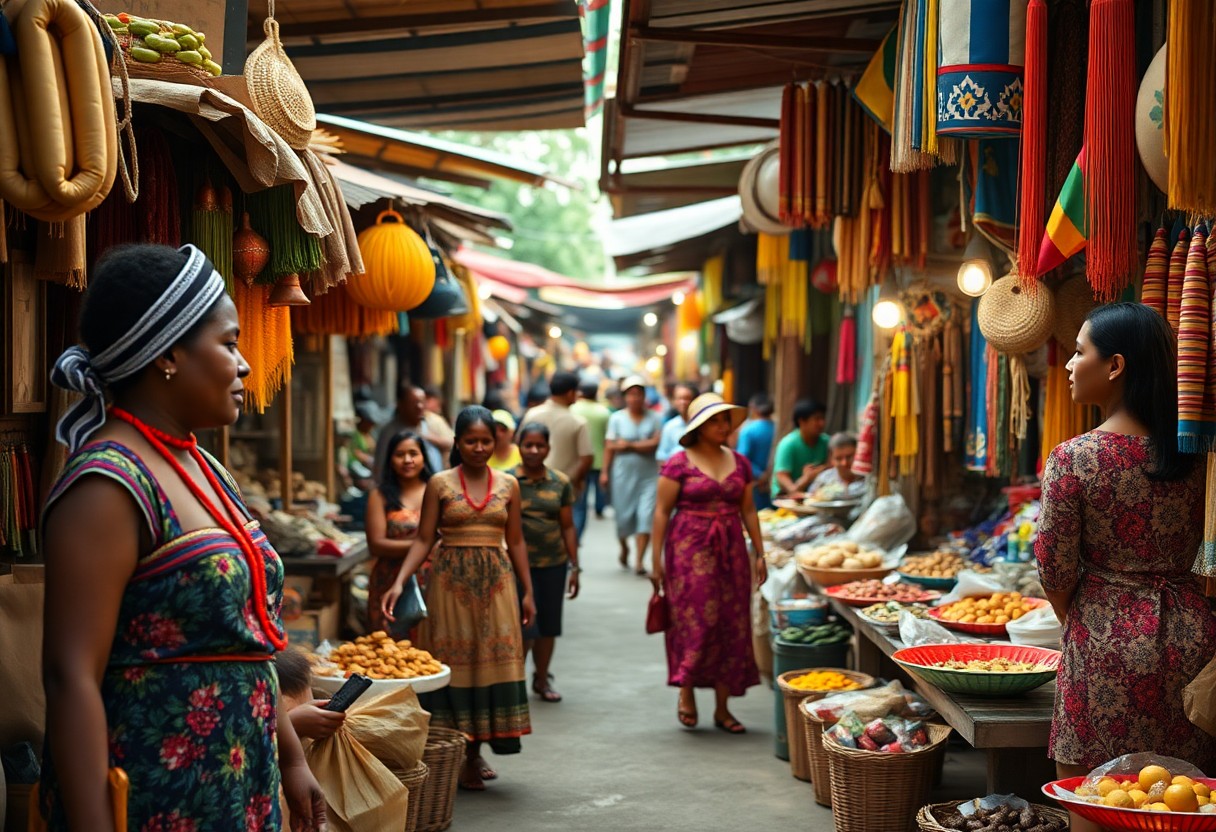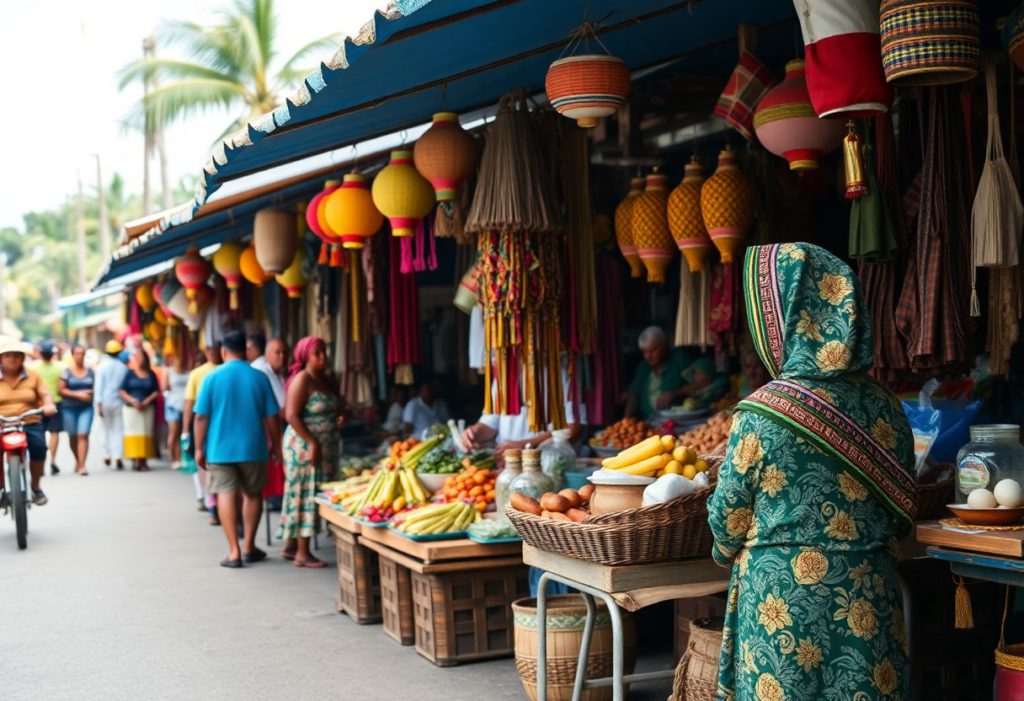Welcome to the enthralling realm of Belize, a nation that is a treasure trove of cultural diversity and a vibrant historical tapestry. Here, you will discover a captivating mixture of ethnic groups coexisting in harmony, showcasing Belize as a true gem of Central America. This unique country features a fascinating amalgamation of Creole, Garifuna, Maya, Mestizo, and numerous other communities. Each group contributes distinctively to the rich cultural fabric of the nation. By exploring the historical narrative of Belize, you will witness how its multicultural identity stands as a remarkable testament to peaceful coexistence and diversity. Each ethnic group brings its own traditions, languages, and cultural practices, shaping a dynamic society that celebrates its differences while nurturing a profound sense of national unity, making Belize an extraordinary destination to explore complex cultural interactions.
 Here’s a detailed exploration of the rich ethnic groups of Belize:
Here’s a detailed exploration of the rich ethnic groups of Belize:
Discover and Understand the Major Ethnic Groups of Belize
The captivating and diverse population of Belize is defined by several distinct ethnic groups, each contributing uniquely to the country's vibrant cultural landscape. This remarkable diversity reflects historical migrations, colonial influences, and deep indigenous roots. Belize's multicultural composition stands out as one of the most ethnically intricate societies in Central America, offering you a unique opportunity to witness the complex dynamics of human migration and cultural integration.
Gain Insights into the Mestizo Community in Belize
To fully appreciate the demographic landscape of Belize, it is crucial to recognize the substantial presence of the Mestizo community, which represents the largest ethnic group, accounting for around 50% of the total population. Primarily descending from a blend of Spanish and Indigenous Mexican heritage, they predominantly settle in the northern and western regions of Belize. Their rich cultural traditions, agricultural knowledge, and practices have significantly influenced the nation’s cultural identity and economic landscape. The Mestizo people embody a fusion of historical narratives that reflect the broader story of Belize and its evolution over time.
Delve into the Creole Heritage and Its Cultural Influence
At the heart of Belize’s cultural identity lies the Creole community, which constitutes approximately 25% of the population. Descendants of African slaves and British colonizers, the Creoles are primarily found in urban areas, especially in Belize City, where their distinctive linguistic and cultural fusion flourishes. Beyond mere demographics, Creole culture is deeply embedded in Belizean music, language, and social customs. Their unique Kriol language serves as both a means of communication and a powerful symbol of cultural resilience and adaptation, reflecting their rich heritage and the ongoing evolution of Belizean society.
Uncover the Enduring Legacy of the Maya People
The Maya communities represent a significant indigenous population with deep historical roots in the region, constituting about 11% of Belize’s overall population. Mainly located in the southern districts, they maintain strong ties to traditional practices that have been passed down through generations. The Maya culture is not just a historical reference; it is a living tradition manifesting in their agricultural practices, spiritual ceremonies, and intricate handicrafts. Their unwavering commitment to preserving ancient languages and customs provides a vital connection to pre-Columbian civilizations, showcasing their enduring legacy and the contributions they continue to make to Belizean culture.
Discover the Unique Afro-Indigenous Garifuna Community
The Garifuna people, an Afro-Indigenous group with a rich history, comprise approximately 6% of Belize’s population. Their roots trace back to Caribbean islands, representing a unique blend of African and Indigenous Caribbean ancestry. The vibrant cultural heritage of the Garifuna is evident in their distinctive music, dance, and linguistic traditions. Recognized by UNESCO for their extraordinary resilience and cultural significance, substantial populations of Garifuna people have settled along Belize’s southern coastal regions, enriching the nation’s cultural landscape and contributing to its diversity.
Explore the Mennonite Community’s Agricultural Contributions in Belize
Representing less than 5% of the population, the Mennonites stand out as a distinct agricultural community in Belize. They adhere to traditional European agricultural practices, significantly contributing to the nation’s agricultural productivity. This community exemplifies remarkable cultural and economic integration. You will find thriving Mennonite settlements, particularly in areas like Spanish Lookout, where they employ highly efficient farming techniques. Their commitment to agriculture and community has made them integral to Belize’s economy and food production, reflecting their values and way of life.
Now, let’s explore the factors that shape Belize’s rich ethnic origins and influences:
Understanding the Historical Influences Shaping Belize’s Ethnic Makeup
A comprehensive understanding of Belize’s ethnic landscape begins with its intricate historical tapestry. You will uncover a rich blend of indigenous Maya heritage, European colonization, descendants of African slaves, and later immigrant groups that have collectively shaped the nation’s diverse cultural identity. The convergence of these diverse populations has created a unique societal framework where multiple ethnicities coexist and interact, resulting in a remarkable multicultural mosaic that defines the social dynamics of Belize.
Examining the Impact of Slavery on Belize’s Ethnic Composition
To fully comprehend Belize’s ethnic composition, it is essential to acknowledge the profound impact of slavery. During the colonial period, African slaves were forcibly brought to work in the mahogany and logwood industries, fundamentally transforming the demographic landscape of the nation. Their resilience and contributions laid the groundwork for Belize’s social and economic development, establishing foundational communities that evolved into the vibrant Creole and Garifuna populations we recognize today. The historical impact of slavery continues to resonate in contemporary Belizean society, influencing cultural expressions and community dynamics.
Understanding Migrations and Refugees’ Role in Shaping Belize’s Ethnic Diversity
Migration patterns have significantly shaped the ethnic diversity of Belize over the years. You will observe that consecutive waves of immigrants from neighboring countries like Guatemala, Honduras, and El Salvador have continuously reshaped the national demographic profile. These migrations have introduced new cultural elements, languages, and traditions that enrich the multicultural environment of Belize. For instance, the arrival of Guatemalan and Salvadoran refugees during regional conflicts in the 1980s brought complex narratives of displacement and survival, leading many to settle in border regions and create dynamic transnational spaces where cultural boundaries blur and new identities emerge, further enriching Belize's social fabric.
 Here’s a glimpse into the vibrant cultural celebrations in Belize:
Here’s a glimpse into the vibrant cultural celebrations in Belize:
Experience the Rich and Vibrant Cultural Celebrations of Belize
Belize’s cultural celebrations are a vibrant display of its rich multicultural tapestry, showcasing the unique traditions contributed by each ethnic group. These festivals transform into colorful displays of heritage, allowing you to participate in extraordinary events such as Garifuna Settlement Day, which highlights indigenous pride, and the lively San Pedro Carnival, where communities unite in joyous festivities. These celebrations serve as not only entertainment but also powerful expressions of national identity and historical resilience, reflecting the deep-rooted connections between Belizeans and their cultural heritage.
Embracing and Celebrating Linguistic Diversity in Belize
Belize is home to an exceptional linguistic diversity, with multiple languages spoken across its communities. While English serves as the official language, you will also encounter Kriol, Spanish, Garifuna, and various Mayan languages. This linguistic richness reflects the cultural interconnectedness and historical migrations that have shaped the nation, creating a unique communicative landscape that embodies the complexity of Belize’s social fabric. The coexistence of different languages facilitates cultural exchange and mutual understanding, enhancing the social cohesion within Belize.
Immerse Yourself in the Musical Heritage of Belize
For the people of Belize, music serves as a profound cultural expression that transcends mere entertainment. You will discover rhythmic traditions that blend African, Caribbean, and Latin American influences, with genres such as Punta, Brukdown, and Reggae dominating the musical landscape. Belize’s musical heritage is deeply rooted in historical migrations and cultural exchanges, with Garifuna drumming being a particularly significant tradition that connects contemporary artists with ancestral rhythms. Each musical style you encounter carries profound social and emotional significance, serving as a living archive of community experiences and collective memory, illustrating how music is integral to Belizean identity.
Dance: A Captivating Medium of Cultural Expression
In Belize, dance performances represent a captivating form of dynamic cultural storytelling. You will witness traditional movements that preserve historical narratives while celebrating community identities. From the rhythmic ceremonial dances of the Garifuna to the vibrant folk performances of the Mestizo people, these artistic expressions offer intimate insights into the multicultural soul of Belize. The significance of dance extends beyond performance; ceremonial movements often connect spiritual practices with historical migrations, illustrating how dance functions as a powerful medium for cultural preservation. Each dance style communicates complex social histories, embodying themes of resilience, resistance, and collective memory through meticulously choreographed movements that tell the stories of Belize's diverse communities.

Navigating the Challenges of Cultural Integration in Belize
As Belize’s multicultural society continues to evolve, it faces complex social dynamics that require careful navigation. You’ll find that ethnic tensions and historical disparities are ongoing challenges that hinder full social integration. Diverse groups within the nation encounter systemic barriers in education, employment, and political representation, necessitating sustained efforts to address these issues. Intercultural dialogue and effective policy interventions are vital in bridging cultural divides and fostering mutual understanding among Belize’s varied ethnic communities, ensuring that all voices are heard and respected in the nation’s ongoing narrative.
Exploring Socioeconomic Disparities Among Belize's Ethnic Groups
Following independence, Belize’s economic landscape revealed significant disparities between ethnic groups. You will observe that Creole, Garifuna, and Maya populations frequently experience higher rates of poverty and limited economic opportunities compared to other communities. These socioeconomic challenges are deeply rooted in historical inequalities, highlighting the need for targeted economic empowerment strategies that promote equitable development across all ethnic groups. Addressing these disparities is crucial for fostering a more inclusive society where all Belizeans can thrive and contribute to the nation’s prosperity.
Embracing Unity in Diversity: Building a Cohesive Belizean Identity
Above all, Belize exemplifies remarkable potential for achieving cultural harmony. Despite their differences, communities share a collective national identity that transcends ethnic boundaries. Intermarriage, shared cultural events, and collaborative social initiatives contribute to a growing sense of national unity. With immense resilience, Belize continues to craft a unique national narrative that celebrates its multicultural heritage. You will witness how various ethnic groups contribute to a vibrant social tapestry, creating innovative cultural expressions that blend diverse traditions. The nation’s commitment to peaceful coexistence serves as a powerful example of cultural integration, where diversity is embraced as a fundamental strength of Belizean society.
Reflecting on the Rich Tapestry of Belize’s Cultural Diversity
In your exploration of Belize’s rich ethnic landscape, you have witnessed how the Maya, Garifuna, Creole, Mestizo, and other communities have woven their unique cultural threads into a vibrant national fabric. Belize stands as a remarkable testament to harmonious multicultural coexistence, where diverse traditions, languages, and histories blend seamlessly. Your journey through this small Central American nation reveals a society that not only celebrates its differences but also upholds a strong sense of shared national identity. By gaining insight into Belize’s ethnic heritage, you can appreciate the depth and complexity of its social dynamics, demonstrating how cultural diversity can serve as a source of strength and unity.
Your Questions Answered: Frequently Asked Questions about Belize’s Ethnic Diversity
Q: Which ethnic groups shape the unique cultural identity of Belize?
A: Belize is a melting pot of ethnic groups, including Mestizos (approximately 52% of the population), Creoles (around 25%), Maya (indigenous groups such as Kekchi and Mopan), Garifuna, as well as smaller communities of East Indians, Chinese, and Mennonites. Each group contributes distinct cultural traditions, languages, and historical narratives that collectively shape Belize’s vibrant multicultural identity.
Q: How do different ethnic communities coexist and interact in Belize?
A: Belize exemplifies a model of peaceful ethnic integration, where communities maintain their unique cultural practices while sharing a cohesive national identity. Intermarriage is common, linguistic diversity is celebrated, and various cultural festivals serve as platforms to showcase the country’s rich heritage. Shared experiences from colonial history and national development have fostered mutual respect and understanding among the different ethnic groups, reinforcing the bonds that unite them.
Q: What historical events have influenced the multicultural development of Belize?
A: The multicultural society of Belize emerged from a series of complex historical processes, including encounters with Spanish colonizers, British colonial administration, African slavery, indigenous resistance, and subsequent waves of migration. Belize’s geographical position as a crossroads between the Caribbean and Central America facilitated cultural exchanges, while policies promoting tolerance and integration have supported the establishment of a harmonious multiethnic national framework.
The article Unpacking Belize’s Diverse Ethnic Heritage and Multicultural Society first appeared on Belize Travel Guide.
The Article Belize’s Ethnic Heritage: A Look at Its Multicultural Society Was Found On https://limitsofstrategy.com



What a beautifully written introduction to Belize’s cultural richness! Your exploration of the various ethnic groups really resonates with me, especially considering how their distinct traditions contribute to a collective identity. It’s fascinating to witness how the blending of these cultures creates such a unique societal fabric.
I’m glad you found the introduction to Belize’s culture engaging! The way those diverse ethnic groups interweave their traditions really does create a fascinating tapestry. It’s interesting to think about how each group brings something unique to the table – whether it’s music, food, or festivals. Take the Garifuna with their vibrant drumming and dance, for instance; their events are electric and hold so much history.
You nailed it; the way the Garifuna express their history through drumming and dance is something special. Their music conveys stories that often date back centuries, capturing their journey in such a vibrant way. I love how their festivals aren’t just celebrations but a living history lesson, connecting generations and fostering a sense of community. The food they bring to the table is just as rich, blending African, Arawakan, and European influences in delicious ways. Did you have a chance to experience a Garifuna festival or listen to their music live? It really immerses you in their culture.
I really appreciate your thoughts on Belize’s cultural richness! It’s fascinating to think about how the different ethnic groups—like the Garifuna, Creole, Mestizo, and Maya—each bring their own flavors and traditions to the table. One thing I love is how food serves as a bridge between these cultures. A simple meal can tell a story of blending ingredients and techniques that speak to the shared experiences and histories of the people.
It’s great to see how much you appreciate the tapestry of cultures in Belize. Food really does have a unique way of weaving people together, and those flavors tell stories that reach deep into the heart of each community.
You’ve captured that sentiment beautifully. The tapestry of cultures in Belize really does make the food scene so vibrant and reflective of its history. It’s fascinating how each dish can tell a story about the people and traditions behind it. I think about how meals often bring families together, whether it’s a simple breakfast or a festive dinner, and how that bonding over food can foster a sense of community.
It’s great to hear that you’re interested in how food acts as a bridge between the various cultures in Belize. You bring up an important point about the stories meals can tell. Each dish often reflects a fusion of different traditions and ingredients that have been shared and adapted over generations.
“I’m glad you’re resonating with the cultural tapestry of Belize! If you’re curious to explore more about these culinary traditions and even try some recipes yourself, check out this link for delicious inspirations.”
https://plumberchoices.co.uk/ParentAler
It’s refreshing to see your appreciation for how food intertwines with the cultural narratives of Belize. The way meals carry stories is a fascinating aspect that often goes unnoticed. Each plate represents a slice of history, a moment of shared experience, and even a dialogue between different communities. Food becomes a medium of memory and a way to express identity.
“Absolutely! If you’re eager to dive deeper into Belize’s vibrant culinary scene and perhaps whip up some of these delightful dishes at home, I highly recommend checking out this link for some tasty inspirations!”
https://plumberchoices.co.uk/quillbot
Belize does have a remarkable tapestry of cultures, doesn’t it? The interplay among its numerous ethnic groups really showcases how a shared space can become a vibrant collage of traditions and practices. Each group brings its own story, reflecting everything from historical conquests to migration waves, and it’s all woven into daily life so seamlessly that you can almost feel it pulse in the air, especially in local festivals or community gatherings.
Thank you for your kind words! If you’re interested in delving deeper into Belize’s vibrant culture, check out this fantastic resource that showcases even more about the country’s rich heritage.
https://plumberchoices.co.uk/consult
You’ve captured the essence of Belize beautifully. The cultural landscape here really does feel like a living tapestry, doesn’t it? When you stroll through the streets of cities like Belize City or San Ignacio, the mingling of Garifuna music, Mestizo cuisine, and Creole stories come together in a way that feels almost magical. It’s in the rhythms of the drums during celebrations, the spicy flavors of the local dishes, and even in the way people greet each other—each moment is infused with history and a sense of belonging.
Absolutely! If you’d like to explore more about the rich tapestry of Belize’s culture and traditions, I highly recommend checking out this insightful resource. It offers a deeper look into the stories and practices that make Belize truly unique.
https://plumberchoices.co.uk/ParentAler
Your exploration of Belize’s multifaceted cultural identity is both enlightening and inspiring. As someone who has been fortunate enough to travel to Belize, I can attest to the richness you describe. Each ethnic group—the Creole, Garifuna, Maya, and Mestizo—offers its own unique flavor to the Belizean experience. It’s fascinating how the confluence of these diverse communities creates such a vibrant tapestry, where music, art, cuisine, and language weave together to tell the nation’s story.
I appreciate your thoughts on Belize’s cultural scene. It’s amazing how each ethnic group contributes its unique charm, isn’t it? When you wander through the streets, you can really feel how the Creole, Garifuna, Maya, and Mestizo communities interact and blend in daily life. The music alone is a testament to that—it’s a mix that makes you want to move, whether it’s the rhythm of Punta or the soulful melodies of Creole music.
Thank you so much for your thoughtful comment! If you’re eager to dive deeper into Belize’s rich cultural experiences, I invite you to explore more through this link.
https://plumberchoices.co.uk/ChocolateHealth
You’ve captured a wonderful essence of Belize’s cultural tapestry. Each community brings its flavors, and it’s fascinating to see how they harmonize both in daily life and through artistic expression. The way the Rhythms of Punta get your feet moving, while the soulful touch of Creole music tugs at your heart, is a beautiful reflection of that blend.
If you’re interested in experiencing more of Belize’s vibrant culture, check out this link for some exciting insights!
https://plumberchoices.co.uk/ChocolateHealth
It’s great to hear that you’ve had the chance to experience Belize firsthand. Each ethnic group really does add its own flair, doesn’t it? When I was there, I was struck by how the music can shift from the rhythmic beats of Garifuna drumming to the soulful sounds of Creole songs, all in one night.
You really nailed it with that description of the music scene. It’s fascinating how it reflects the country’s cultural tapestry. When I was there, I found moments where the intermingling of those sounds created a sort of musical dialogue. One minute, you’re caught up in the vivid energy of a Garifuna celebration, and the next, the smooth Creole melodies guide you into a reflective space. It’s as if the music itself tells the story of the land and its people. Did you try any local dance moves while you were there? They really capture the essence of that rhythmic variety.
Absolutely! The diverse musical landscape truly reflects the richness of Belize’s culture. If you’re looking to explore more about this vibrant destination and its unique experiences, check out this link for some great insights!
https://plumberchoices.co.uk/FaceTune
It’s amazing how music can serve as a language of its own, isn’t it? The way it weaves together the various cultural identities is such a beautiful experience. I remember bewitching moments in those Garifuna celebrations, where the drumming and dancing felt like they could transcend time. It’s like you said—a musical dialogue that speaks to the heart of the place.
It’s great to hear your perspective as someone who has traveled to Belize. The way you describe the unique flavors each ethnic group brings is spot on. I remember listening to Garifuna music during a cultural festival—there’s something so uplifting about those ancestral rhythms that really embodies the spirit of the people.
Listening to Garifuna music at a cultural festival must have been a wonderful experience. The rhythm and energy can almost lift you off your feet, can’t it? It’s fascinating how music serves as a living testament to the history and resilience of the Garifuna people. Those beats, often accompanied by storytelling and dance, create a vibrant tapestry that reflects their struggles, triumphs, and cultural identity. It’s not just entertainment; it’s a connection to generations that came before.
“I’m glad you enjoyed the rhythms of Garifuna music! If you’re looking to dive deeper into Belize’s vibrant culture and flavors, check out this guide for more insights on experiencing it all firsthand.”
https://plumberchoices.co.uk/ChocolateHealth
It’s great to hear you’ve had the chance to experience Belize firsthand. The way each ethnic group contributes to the country’s cultural landscape is truly remarkable. Take the Garifuna, for instance; their music and dance convey centuries of resilience and heritage, while the Creole community brings its own distinctive flavor through language and culinary traditions.
I’m glad you appreciated the exploration! If you’re interested in diving deeper into Belize’s cultural treasures, check out this resource for a closer look at the vibrant experiences waiting for you.
https://plumberchoices.co.uk/ParentAler
It’s great to hear that you’ve experienced the richness of Belize for yourself. Each ethnic group really does bring something special to the table, doesn’t it? The way they blend together is like a never-ending potluck where every dish tells a story.
I really love how you’ve highlighted the multicultural aspect of Belize! It’s fascinating to think about how these diverse communities not only coexist but also enrich each other’s traditions. The Garifuna culture, for instance, is so unique with its music and dance—like punta and huelong—which really bring a sense of vibrancy to the country.
It’s great to see your appreciation for the multicultural aspect of Belize. The way different communities blend and share their customs truly enriches the fabric of the country. The Garifuna culture, with its distinctive music and dance, is indeed a vibrant part of Belizean life. I’ve always found it interesting how traditional art forms, like punta and huelong, serve not just as entertainment but also as a means of storytelling and cultural preservation.
You’ve touched on something really significant with the Garifuna culture. It’s fascinating how music and dance go beyond just fun activities—they serve as a bridge connecting generations. Punta and huelong, for example, encapsulate stories, emotions, and history, creating a living narrative that evolves yet stays rooted in tradition.
Absolutely! If you’re interested in exploring more about Belize’s rich cultural heritage and the vibrant expressions of the Garifuna community, check out this link for some incredible insights and experiences.
https://plumberchoices.co.uk/krystal
The Garifuna culture is truly a vibrant part of Belize’s identity, and you’re spot on about the music and dance being central to their community. Punta and huelong are more than just dances; they’re a way for the Garifuna people to express their history and resilience. Each beat and move often tells a story, showcasing their roots and the blend of African, Arawakan, and Carib influences over the years.